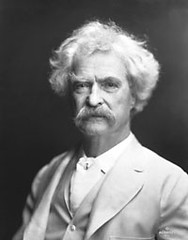There are many rules for writing.  Some are followed; some are ignored. And, somehow, it seems in much of today’s published fiction many have never been heard of.
Some are followed; some are ignored. And, somehow, it seems in much of today’s published fiction many have never been heard of.
 Mark Twain divides his rules for story-telling into large rules and little rules:
Mark Twain divides his rules for story-telling into large rules and little rules:
Large rules:
1. A tale shall accomplish something and arrive somewhere. 
2. The episodes of a tale shall be necessary parts of the tale, and shall help develop it. 
3. The personages in a tale shall be alive, except in the case of corpses, and that always the reader shall be able to tell the corpses from the others. 
4. The personages in a tale, both dead and alive, shall exhibit a sufficient excuse for being there. 
5. When the personages of a tale deal in conversation, the talk shall sound like human talk, and be talk such as human beings would be likely to talk in the given circumstances, and have a discoverable meaning, also a discoverable purpose, and a show of relevancy, and remain in the neighborhood of the subject in hand, and be interesting to the reader, and help out the tale, and stop when the people cannot think of anything more to say.
6. The personages of a tale shall confine themselves to possibilities and let miracles alone; or, if they venture a miracle, the author must so plausibly set it forth as to make it look possible and reasonable. 
Little rules:
7. An author should say what he is proposing to say, not merely come near it.



